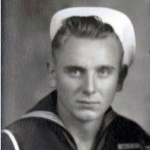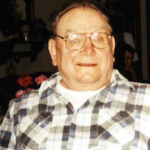Papenfuss, Clarence Raymond, Seaman 1st Class USNR


Duty Assignment
USS Saugatuck (AO 75) (Commissioning Crew / Plank Owner)
Deck Force 2nd Division
Rigging/Fueling @ Sea
Gun watches on the 20mm
SERVICE HISTORY
11/5/1942: Boot Camp: Great Lakes, Ill.
Philadelphia, PA until assigned to U.S.S. Saugatuck – A0 75
01/1943: Shake Down of U.S.S. Saugatuck – A0 75
U.S.S. Saugatuk – AO 75 – Baltimore, MD
02/19/1943: Commissioning Crew of U.S.S. Saugatuck – A0 75
03/1943 depart for Aruba S.A. for fueling operations
1944: Transferred off U.S.S. Saugatuck – A0 75 in San Francisco
Treasure Island Naval Station (Await transfer to DD 803)
Stationed at Treasure Island for 3 months at Market Street Shore Patrol.
San Francisco, stood guard duty at double doors on the 2nd floor.
08/19/1944: Commissioning Crew of U.S.S. Little, DD 803
05/03/1945: Sinking of DD 803 by Kamikazes at Okinawa
Treasure Island – Then 30 day survivors leave
Banning Naval Hospital Fire Department until closing
Chollas Heights Naval Radio Station
02/10/1946: Ft. Snelling, MN – Honorable Discharge
MEMORIES
While Stationed Aboard the U.S.S. Saugatuck AO75
Being assigned to the Saugatuck commissioning crew in January 1943. There were 35 men on-board at the time when we left Chester, PA. There were still some civilian welders aboard at the time from what I remember. We went to Baltimore for refitting and then to VA for the shakedown cruise. We managed to run aground and had to go back to dry docks to see if the sounding gear or the bottom was damaged. If I remember correctly we went to New Port Island for repairs.
Getting my hair cut off and running through garbage shoots during initiation when I became a Shellbacker on the U.S.S. Saugatuck on May 3, 1943. Captain Koerner – longitude 87 degree 22 west
Dropping a shotgun down the vents which broke some valves and gauges in the boiler room while I was standing over the bakery while on guard duty. Was restricted to the ship for 30 days but we were at sea for 40 so it never made a difference.
Served as an orderly to Captain Koerner when we pulled into harbors. Did this for 3 months in 1943-1944 around the time we were in Paptte, Tahiti.
During a typhoon in 1943 off the coast of Australia we cut cables on all the oil drums and acetylene tanks and let them go overboard. We kept the 2 or 4 Corsairs that were tied down. The ship would go through one wave and you would hear a real loud crack, then you would go straight through the next. At times the screw came totally out of the water and the ship would shutter. I never thought anything of it… we were young and didn’t know any better. The storm went on for about two days.
Going through the Panama Canal on the way to Sydney, Australia. A hospital ship was sunk and our course was changed to Esparitos Santos instead. A bearing went out in one of the screws and we stopped for a day while it was repaired. I remember the Dr. catching a shark and they hoisted it onto the ship. The Dr. cut him open and pulled out a white hat and said, “look, he ate a guy… all that’s left is his cap.” He was trying to scare all the young guys.
Later on in Esparitos Santos one of the Corsairs was dropped into the ocean when a cable broke on one of the winches. They brought in a deep sea diver to hook onto it and they pulled it back up. The first time they pulled up a piece of coral, the second time the Corsair came back.
Going ashore in San Bula, Fiji in 1943 and running into a bunch of other military guys. When they asked where I was from I said North Dakota. They said there were a whole bunch of guys from ND at the barracks. Turned out a friend from ND in the 164th Infantry was there. I went to the barracks and there was Harold sitting on his cot cleaning his M1. That Sunday Harold, Cliff Martin, Max Nagle (AO 75 Cook) and I ate dinner on the Saugatuck. Who would have thought you’d have four guys from small town ND all being in Fiji at the same time.
Going to a shore beer party and seeing signs warning of head hunters. Couldn’t drink aboard the ship but had beer parties on the islands at times. I can remember picnic tables of all things.
Cordinea (spelling?) the ships head baker – from Chicago I think.
Tate, the gunnery officer taking us to fire fighting school.
The hard work, but good food!
Gene Tuney – World Champion Boxer fighting with one hand tied behind his back a Golden Glove boxer and winning.
Hearing one guy who always said, “I want to get off this damn rust bucket… all I do is work, work, work.”
Being stationed with my friend Albert Parker from Boot Camp. We both transferred off at the same time and were fortunate enough to have both been transferred to to DD 803.
While Stationed Aboard the U.S.S. Little DD803
The below is my dad’s account of May 3, 1945 when the U.S.S. Little DD 803 was sunk.
“On the night we were sunk off of Okinawa I was throwing powder kegs below the # 4 5”. Everything went dead and we looked at each other and someone asked, “now what do we do?” … let’s get the hell out of here. We opened the hatch and walked onto the deck. I can remember seeing guys laying on the deck who were badly burnt and Chester Petrowski and a few others at the back of the ship trying to shoot one of the 20mm. By that time the water was up on the deck, so we just walked off the side of the ship into the ocean.
Once I was in the water the something exploded, I believe it was the depth charges. It was the worst feeling I’ve ever had… It was one hell of an enema.
The first time I was in the water I was with a large group of survivors. After about two hours in the water we were picked up by a ship, (I don’t remember if I actually made it on that ship or if we were in rafts along side) which was sunk shortly afterwards. I once again found myself in the water, but his time was in a raft. In a raft next to me was an officer whose leg was messed up. During this time we were almost hit by a plane that was shot down. It hit the water 15 – 20′ from the raft and I remember all of us paddling like hell to get away while thinking this was the end. An hour passed until we were picked up again. Once on the ship I saw wounded shipmates on tables everywhere. There was a Pharmacists Mate on board but no doctor that I could see. We were instructed to give morphine shots to the wounded and had 5-quart bottles of whiskey by the coffee table to use as well. We also attempted to put life jackets on the wounded and burned. It was a horrible experience and all I wanted to do was get the hell out of there.
Eventually I wound up on the U.S.S. Lauderdale and took it to Siapan where I transferred to a troop ship that took me back stateside.”
[ Military records show the Little sinking at 6:55 p.m. on 05-03-1945. The LSM-R 195 sank 10 – 15 minutes later. The Deck log of the LCS (L) (3) 83 shows Clarence on board at midnight and was transferred to the PCE 853 at 12:10 a.m. – 4:00 a.m.]
Other Memories
Joe Grace – Outfielder for St. Louis Browns was my bootcamp company commander.
Glenfield Men Among Survivors Of U.S. Ship Sunk Off Okinawa
Two Glenfield men, Clarence Raymond Papenfuss, seaman first class, and Andrew William Felt, jr., motor machinist’s mate, third class, are among the survivors of the USS Little, sunk May 3 off Okinawa, who have arrived at the U.S. Receiving Ship on Treasure Island, Calif., enroute home on a 30-day survivor leave. Of the original crew of 340, seven are known dead, 29 missing and 63 wounded.
The Little, with the help of combat air patrols, had been successful in driving off several Nip air attacks, but several planes of a group of approximately 24 slipped through the defenses of the ship and the combat air patrol, registering four hits on the destroyer in five minutes.
The order to abandon ship was given shortly after the fourth hit and the crew took to the water. The task of picking up survivors was completed about three and one-half hours later.
The Little, commissioned in Seattle August 19, 1944, was a veteran of seven months action in the Pacific, having participated in the shore bombardments of Iwo Jima and Ie Shima. At the time of its sinking it was doing picket duty approximately 70 miles due west of Okinawa.
[Cooperstown, ND – Griggs County Sentinel-Courier [??/??/1945]
Clarence Raymond Papenfuss, 76, Glenfield, died Friday, Sept. 27, 2002, in Carrington (N.D.) Health Center.
Mr. Papenfuss was born Oct. 9, 1925, near Glenfield, where he grew up and attended school. He joined the U.S. Navy in 1942 and served during World War II. Following his military discharge in 1946, he worked for the Peavey Elevator Co., Glenfield. On Feb. 5, 1964, he married Eunice Saxberg in New Rockford, N.D. They lived in Glenfield.
He is survived by his wife; a son, Larry (Susan), Hutchinson, Kansas; two daughters, Laura Harding, Carrington, LuAnn (Richard) Sitte, Lisbon, N.D.; a brother, Norman, Carrington; three sisters, Inez (Paulmer) Slind, Poulsbo, Wash., Elsie Hoffman, Minneapolis, Elaine Felt, Edmonds, Wash.; and seven grandchildren.
Visitation: Today from 9 to 8:30, with a prayer service at 7, in Evans Funeral Home, Carrington.
Funeral: Tuesday at 10:30 in Glenfield Lutheran Church.
Burial: Glenfield Cemetery.
